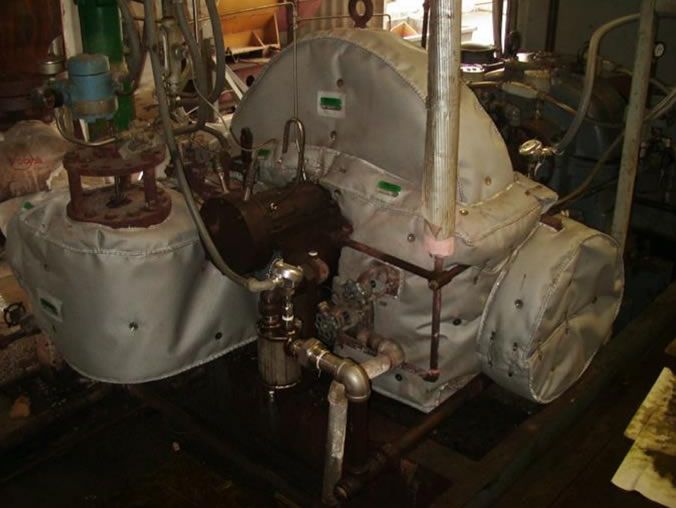MID TEMPERATURE THERMAL STEAM PROCESS
MT800SGM (MT427C-SGM)
INTRODUCTION
Shannon Thermal Blankets are a CAD designed, CNC produced, high quality pre-engineered insulation system designed to save energy, retain radiant heat, minimize insulation maintenance and improve the surrounding work environment. Shannon Thermal Blankets are weather and chemical resistant. Shannon Thermal Blankets are flexible, easy to install, remove and reinstall allowing quick and easy serviceability. The key benefit is re-usability.
Common Applications and Markets
Shannon Thermal Blanket Applications include: Gate Valves, Small Steam Turbines, Globe Valves, Flanges, Expansion Joints, Feed Water Pumps and Pressure Reducing Stations, Boiler Components. Shannon Thermal Blanket Markets: Steam, District Heating, Boiler Rooms, Power Plants.
Service Temperature/Condition
Steam Systems above 550F (288˚C). This design is to act as a Thermal Barrier with a maximum service temperature of 800˚F (427˚C).
Blanket Components
The Outer Jacket is a 17.0 oz/yd² (577g/m²) Silicone Impregnated Fiberglass Cloth. The inner jacket consists of a layer of Stainless Steel Knitted Wire Mesh on the outside, encasing a layer of 18.0 oz/yd² (611g/m²) Plain Fiberglass Cloth. The Insulation Core Material is an 11 lb/ft3 (176.2 kg/m³) Fiberglass Needled Mat-Type E Fiber. The Fiberglass Mat is encapsulated by the outer Silicone Fiberglass Cloth, inner Plain Fiberglass Cloth and Stainless Steel Knitted Wire Mesh, sewn together, producing a Self-Contained Blanket System. The Shannon Thermal Blanket System includes Integral Fasteners for install & removal.

D-R Model 701F – Single Stage HP Steam Turbine
BLANKET THICKNESS SURFACE TEMPERATURE REFERENCE
Operating Temp |
Thickness |
Surface Temp |
Thickness |
Surface Temp |
Thickness |
Surface Temp |
|---|---|---|---|---|---|---|
| 232˚ C (450˚ F) | 25 mm( 1″) | 57.2˚ C (135.1˚ F) | 40 mm( 1.5″) | 47.8˚ C (118.0˚ F) | 50 mm (2″) | 42.3˚ C (108.2˚ F) |
| 260˚ C (500˚ F) | 25 mm( 1″) | 62.5˚ C (144.5˚ F) | 40 mm( 1.5″) | 51.7˚ C (125.1˚ F) | 50 mm (2″) | 45.5˚ C (113.9˚ F) |
| 287.8˚ C (550˚ F) | 25 mm( 1″) | 67.9˚ C (154.2˚ F) | 40 mm( 1.5″) | 55.8˚ C (132.4˚ F) | 50 mm (2″) | 48.9˚ C (119.9˚ F) |
| 315.6˚ C (600˚ F) | 25 mm( 1″) | 72.5˚ C (162.5˚ F) | 40 mm( 1.5″) | 59.7˚ C (139.5˚ F) | 50 mm (2″) | 52.2˚ C (126.0˚ F) |
| 343.3˚ C (650˚ F) | 25 mm( 1″) | 79.4˚ C (175.0˚ F) | 40 mm( 1.5″) | 64.4˚ C (148.0˚ F) | 50 mm (2″) | 56.1˚ C (133.0˚ F) |
| 371˚ C (700˚ F) | 40 mm(1.5″) | 69.2˚ C (156.5˚ F) | 50 mm (2″) | 59.8˚ C (139.6˚ F) | 65 mm (2.5″) | 53.6˚ C (128.4˚ F) |
| 427˚ C (800˚ F) | 40 mm(1.5″) | 79.2˚ C (174.6˚ F) | 50 mm (2″) | 68.1˚ C (154.5˚ F) | 65 mm (2.5″) | 60.7˚ C (141.2˚ F) |
* The above referenced Cold Face Surface Temperatures should be used as guidelines for blanket insulation thickness design.
* The Cold Face Surface Temperature of the blanket should approach surrounding ambient temperature conditions.
* The economic thickness of the blanket should consider blanket cost, thermal performance and blanket design constraints.
* Heat loss calculations are based on a 21.1˚ C (70˚ F) ambient temperature using a flat surface condition.
